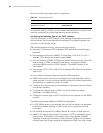
92 CHAPTER 5: IP ROUTING PROTOCOL OPERATION
are propagated in the OSPF AS. However, the type-5 LSAs do not reach Area 1
because Area 1 is an NSSA. NSSAs and STUB areas have the same approach in this
aspect.
Similar to a STUB area, the NSSA cannot be configured with virtual links.
Figure 5 NSSA
Perform the following configuration in OSPF Area view.
All routers connected to the NSSA must use the nssa command to configure the
area with the NSSA attribute.
The default-route-advertise parameter is used to generate the default type-7
LSAs. The default type-7 LSA route is generated on the ABR, even though the
default route 0.0.0.0 is not in the routing table. On an ASBR, however, the default
type-7 LSA route can be generated only if the default route 0.0.0.0 is in the
routing table.
Executing the no-import-route command on the ASBR prevents the external
routes that OSPF imported through the import-route command from advertising
to the NSSA. Generally, if an NSSA router is both ASBR and ABR, this argument is
used.
The default-cost command is used on the ABR attached to the NSSA. Using this
command, you can configure the default route cost on the ABR to NSSA.
By default, the NSSA is not configured, and the cost of the default route to the
NSSA is 1.
Configuring the Route Summarization of OSPF Area
Route summary means that ABR can aggregate information of the routes of the
same prefix and advertise only one route to other areas. An area can be
configured with multiple aggregate segments allowing OSPF to summarize them.
Table 37 Configuring NSSA of OSPF
Operation Command
Configure an area to be the NSSA area nssa [ default-route-advertise ] [
no-import-route ] [ no-summary ]
Cancel the configured NSSA undo nssa
Configure the default cost value of the route
to the NSSA
default-cost cost
Restore the default cost value of the route to
the NSSA area
undo default-cost
RIP
RIP
Area 2
Area 0
Area 1
NSSA
NSSA
ABR
NSSA
ASBR


















